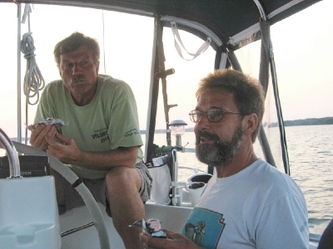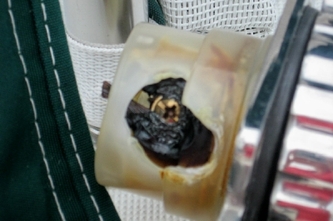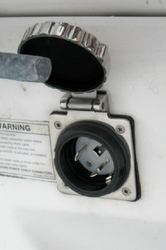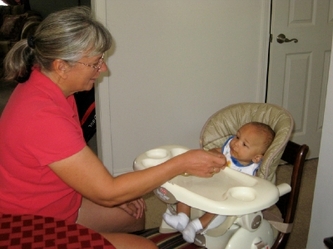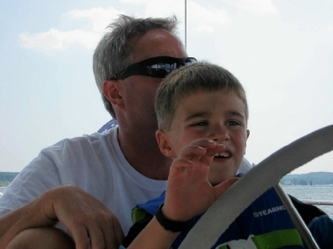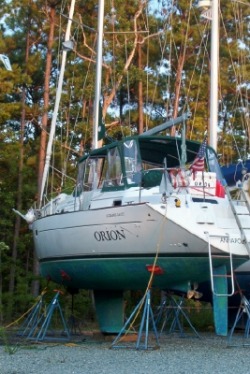
Orion on the hard in Deltaville
We never thought that we would be sending this update from 10 feet above ground, but that’s where Orion is now – on the hard at Deltaville Boatyard. But more about how that happened later. Our weeks of dockside life in Hampton ended abruptly 2 weeks ago, when we decided to set out for Solomons and Deltaville to have some work done on Orion.

Bonnie Lass anchored in the Severn River – the one off Mobjack Bay.
Bonnie Lass, Is That You?
As we rounded Old Point Comfort on our way out of Hampton (on Friday, August 1st), we decided to give a hail to Bonnie Lass on the VHF. They were supposed to be nearby, but we had not had luck reaching them on the cell phone. Sure enough, we got a response. They were less than an hour behind us, having successfully navigated the last of the ICW bridges only minutes before. We were headed in the same direction, so we agreed to rendezvous in Mobjack Bay on the Severn River.
Val and Graham joined us for dinner on Orion that night, while we caught up with their travels since we’d seen them last (at Riviera Beach). These included an extended time in the Exumas chain of the Bahamas. Since this is likely our destination this winter, we were eager to hear about their experiences.
We were headed generally in the same direction now (we to Solomons and Bonnie Lass to Olversons Marina on the Potomac). So we traveled together another day to Sandy Point on the Great Wicomico. Thunderstorms were threatening all day, but we luckily avoided them until after we had been anchored for several hours behind Sandy Point. Then they came rolling through one after another for the rest of the evening. Our planned dinner on Bonnie Lass was scuttled, so we did a “progressive dinner” of sorts, with Dave ferrying dishes back and forth between storms.
We parted company the next morning, since we needed to make Solomons by Sunday afternoon, if possible, and the travel weather was not the best for a northerly trip if you didn’t have to do it. We hope to see Val and Graham again this fall, once their month at Olverson’s is done and we are moving more as well.
As we rounded Old Point Comfort on our way out of Hampton (on Friday, August 1st), we decided to give a hail to Bonnie Lass on the VHF. They were supposed to be nearby, but we had not had luck reaching them on the cell phone. Sure enough, we got a response. They were less than an hour behind us, having successfully navigated the last of the ICW bridges only minutes before. We were headed in the same direction, so we agreed to rendezvous in Mobjack Bay on the Severn River.
Val and Graham joined us for dinner on Orion that night, while we caught up with their travels since we’d seen them last (at Riviera Beach). These included an extended time in the Exumas chain of the Bahamas. Since this is likely our destination this winter, we were eager to hear about their experiences.
We were headed generally in the same direction now (we to Solomons and Bonnie Lass to Olversons Marina on the Potomac). So we traveled together another day to Sandy Point on the Great Wicomico. Thunderstorms were threatening all day, but we luckily avoided them until after we had been anchored for several hours behind Sandy Point. Then they came rolling through one after another for the rest of the evening. Our planned dinner on Bonnie Lass was scuttled, so we did a “progressive dinner” of sorts, with Dave ferrying dishes back and forth between storms.
We parted company the next morning, since we needed to make Solomons by Sunday afternoon, if possible, and the travel weather was not the best for a northerly trip if you didn’t have to do it. We hope to see Val and Graham again this fall, once their month at Olverson’s is done and we are moving more as well.
What are those white things for anyway?
Although we do a lot of motoring on Orion, we do actually use our sails, both while motor sailing or pure sailing. Having replaced our main sail back in 2005, we knew that our headsail was due to be replaced. If we made it to the Bahamas as planned, we would have more opportunity to do some pure sailing, so we thought now was the time to bite the bullet and shop for a new headsail.
Our motivation for getting to Solomons Sunday evening was to meet with Bruce Empey, from Neil Pryde Sails in Annapolis about a replacement headsail. Bruce had been terrific in working with us to replace our main sail just after we purchased Orion back in 2005. He had also re-cut our headsail back then to raise the foot and give us more visibility when close-hauled. When we said we could get the boat to Solomons, he graciously agreed to drive down from Annapolis (on a Sunday evening, no less) to meet us and discuss the sail’s specifications.
Visibility continues to be the biggest issue with our headsail, when sailing Orion close-hauled. The center cockpit design puts us higher in the boat, unlike the more prevalent rear cockpit designs. This requires us to literally lie down to see under the sail. This is wearying when you’re traveling long distances, so the loss of performance that a shorter sail might deliver is a small price to pay for the increased visibility in a comfortable position. The other improvement we were looking for was to be able to point higher (i.e., sail closer to the wind) when the sail is furled.
Bruce took measurements of the existing sail and worked with us to confirm the height from the bow rail that would give the desired visibility. This would require the genoa car to sit back about a foot from the midpoint to produce the right curve in the sail when it is completely unfurled. He also answered our questions about luff pads, which several friends had mentioned. These are intended to make a furled sail less baggy, and therefore help it retain a more aero-dynamic shape than would otherwise be achievable. We decided to include this option on our sail. The luff pads would actually be installed as thin strips of foam along the middle of the sail.
With pencil and ruler in hand, Bruce sketched out a scale drawing of the new sail as we sat in the cockpit of the boat. It would be slightly bigger than our existing sail (by 12 square feet), and would incorporate the changes we requested. By ordering this early for a fall delivery, we were also able to take advantage of some reduced shipping costs, while still taking delivery by the time of the Annapolis Boat Show.
Engine Tuning
Dave had been communicating with Matt at Deltaville Boatyard for several months about coming in to have some engine work done on Orion. Although we had (we hope) taken care of the problems with the raw water strainer, Dave was interested in getting another mechanic to look at the engine oil leak that had been persisting for a couple of years. We had also lost a piece of the impeller that needed to be found and removed as well. This was most likely lodged in the heat exchanger. So, it made sense to remove and clean this at the same time. A more recent problem that we hoped could be found was the reason behind our need to bleed the fuel line every time the boat sat for a few days in the soaring Hampton temperatures. Finally, we wanted to install some engine gauges to give a better sense of what was happening with the engine before it turned into a crisis.
So, we headed from Solomons to Deltaville on Tuesday (August 5th) to meet with the boatyard and see about starting the work on the engine. In talking to Matt the next morning, he suggested that we would want to think about changing antifreeze at the same time we opened up the heat exchanger, since we would have to drain much of this in order to open it up. He also suggested we consider hauling the boat to check the bottom paint and thru-hulls.
By Thursday, the Yanmar mechanic, John, came onboard to review the work and the engine access (which was obviously a pleasant surprise) in order to give us an estimate. That review identified the fuel lift pump as needing replacing and as a potential source of both oil and fuel leaks. Work started in earnest on Monday, as John put a dye in the engine oil to help identify the source of the leaks. Running the engine with the dye pointed to a number of small sources of leaks in addition to the fuel pump. There were new washers required behind some bleed screws and the injectors. Once the pump and the new washers were in place, the leaks seemed to be gone. Although only time (about 100 engine hours) will tell for sure, we’re cautiously optimistic.
John then turned his attention to the heat exchanger, draining the current green antifreeze, which would be replaced by the extended life (pink) antifreeze. Since the 2 types of antifreeze are incompatible, the system needed to be flushed several times – with water, then a mild soap, then more water -- before adding the new antifreeze. Once completed, John disassembled the heat exchanger and removed the inner parts to be cleaned. The next day, he re-assembled the heat exchanger (replacing one of the hoses in the process) filled the system with extended life antifreeze and ran the engine to remove any air in the lines, continuing to look for leaks as the engine ran. After he left, we ran the engine for 90 minutes under load, which confirmed for John the next day that any air bubbles in the cooling system had been purged, and that no undetected leaks had appeared. So, he changed the oil to remove the dye and, at Dave’s request, drained the Racor fuel filter and cleaned the bowl, which had blackened over time.
Dave was pleased with the work John did – both with his expertise and his willingness to let Dave observe what he did. Deltaville Boatyard is also good at working with us to reduce costs, using our spare parts when possible and letting us know what work we can do to reduce the time their workers spend on the job.
So, why are we high and dry?
While John reviewed the engine, he confirmed that there was no leak at the rear seal between the transmission and the drive shaft, thus eliminating a possible need to haul the boat for that reason. However, Matt was pretty sure we had work to be done on the bottom, despite the reassurances to the contrary of several divers we have had clean the bottom over the past few months. Matt offered a complementary haul-out to prove his point, and sure enough, it was obvious that the bottom paint was gone in enough places that we should bite the bullet and paint it now.
This set in motion a number of changes in plans. Having the boat out of the water would mean we would have a safe (i.e., hurricane-protected) place to keep Orion while we traveled north to help Fred bring Marianna south. So, we decided to keep the boat out of the water for about a month until late September, when we returned with Marianna. This would save the slip fees and diver expenses of having the boat in the water, but not moving all that time.
Since we wouldn’t be leaving to go north for a few weeks, for the first time, we would be living on the boat 10 feet up in the air. Although we would have electric, there would be no A/C, so we had to hope for cooler temperatures as August wound down. Our grandson, Droz, was coming for a visit as well, so this might become an interesting adventure, living in the “treehouse” that was Orion on the hard. Hopefully, he will see it that way.
Being suddenly out of the water, we began re-thinking our boat projects to ensure we took advantage of the time out of the water. Within minutes of being hauled, Dave replaced the zinc on the end of the prop. Later, we scraped the barnacles off the hull and put grease in the head and galley thru-hulls. Next Dave used On and Off, a strong hull cleaner, to remove the notorious ICW “mustache” (the tea stain on the bow and the waterline) and recover the gleaming white gelcoat underneath. (Of course it removed all the wax as well, which will be another project.) There’s more to do, of course, but we’ve only had a couple of days so far.
We will need to continue to prepare the bottom for painting, wax the hull and finish the above deck projects that the intense summer heat have kept us from finishing.
Other Projects
Although we do a lot of motoring on Orion, we do actually use our sails, both while motor sailing or pure sailing. Having replaced our main sail back in 2005, we knew that our headsail was due to be replaced. If we made it to the Bahamas as planned, we would have more opportunity to do some pure sailing, so we thought now was the time to bite the bullet and shop for a new headsail.
Our motivation for getting to Solomons Sunday evening was to meet with Bruce Empey, from Neil Pryde Sails in Annapolis about a replacement headsail. Bruce had been terrific in working with us to replace our main sail just after we purchased Orion back in 2005. He had also re-cut our headsail back then to raise the foot and give us more visibility when close-hauled. When we said we could get the boat to Solomons, he graciously agreed to drive down from Annapolis (on a Sunday evening, no less) to meet us and discuss the sail’s specifications.
Visibility continues to be the biggest issue with our headsail, when sailing Orion close-hauled. The center cockpit design puts us higher in the boat, unlike the more prevalent rear cockpit designs. This requires us to literally lie down to see under the sail. This is wearying when you’re traveling long distances, so the loss of performance that a shorter sail might deliver is a small price to pay for the increased visibility in a comfortable position. The other improvement we were looking for was to be able to point higher (i.e., sail closer to the wind) when the sail is furled.
Bruce took measurements of the existing sail and worked with us to confirm the height from the bow rail that would give the desired visibility. This would require the genoa car to sit back about a foot from the midpoint to produce the right curve in the sail when it is completely unfurled. He also answered our questions about luff pads, which several friends had mentioned. These are intended to make a furled sail less baggy, and therefore help it retain a more aero-dynamic shape than would otherwise be achievable. We decided to include this option on our sail. The luff pads would actually be installed as thin strips of foam along the middle of the sail.
With pencil and ruler in hand, Bruce sketched out a scale drawing of the new sail as we sat in the cockpit of the boat. It would be slightly bigger than our existing sail (by 12 square feet), and would incorporate the changes we requested. By ordering this early for a fall delivery, we were also able to take advantage of some reduced shipping costs, while still taking delivery by the time of the Annapolis Boat Show.
Engine Tuning
Dave had been communicating with Matt at Deltaville Boatyard for several months about coming in to have some engine work done on Orion. Although we had (we hope) taken care of the problems with the raw water strainer, Dave was interested in getting another mechanic to look at the engine oil leak that had been persisting for a couple of years. We had also lost a piece of the impeller that needed to be found and removed as well. This was most likely lodged in the heat exchanger. So, it made sense to remove and clean this at the same time. A more recent problem that we hoped could be found was the reason behind our need to bleed the fuel line every time the boat sat for a few days in the soaring Hampton temperatures. Finally, we wanted to install some engine gauges to give a better sense of what was happening with the engine before it turned into a crisis.
So, we headed from Solomons to Deltaville on Tuesday (August 5th) to meet with the boatyard and see about starting the work on the engine. In talking to Matt the next morning, he suggested that we would want to think about changing antifreeze at the same time we opened up the heat exchanger, since we would have to drain much of this in order to open it up. He also suggested we consider hauling the boat to check the bottom paint and thru-hulls.
By Thursday, the Yanmar mechanic, John, came onboard to review the work and the engine access (which was obviously a pleasant surprise) in order to give us an estimate. That review identified the fuel lift pump as needing replacing and as a potential source of both oil and fuel leaks. Work started in earnest on Monday, as John put a dye in the engine oil to help identify the source of the leaks. Running the engine with the dye pointed to a number of small sources of leaks in addition to the fuel pump. There were new washers required behind some bleed screws and the injectors. Once the pump and the new washers were in place, the leaks seemed to be gone. Although only time (about 100 engine hours) will tell for sure, we’re cautiously optimistic.
John then turned his attention to the heat exchanger, draining the current green antifreeze, which would be replaced by the extended life (pink) antifreeze. Since the 2 types of antifreeze are incompatible, the system needed to be flushed several times – with water, then a mild soap, then more water -- before adding the new antifreeze. Once completed, John disassembled the heat exchanger and removed the inner parts to be cleaned. The next day, he re-assembled the heat exchanger (replacing one of the hoses in the process) filled the system with extended life antifreeze and ran the engine to remove any air in the lines, continuing to look for leaks as the engine ran. After he left, we ran the engine for 90 minutes under load, which confirmed for John the next day that any air bubbles in the cooling system had been purged, and that no undetected leaks had appeared. So, he changed the oil to remove the dye and, at Dave’s request, drained the Racor fuel filter and cleaned the bowl, which had blackened over time.
Dave was pleased with the work John did – both with his expertise and his willingness to let Dave observe what he did. Deltaville Boatyard is also good at working with us to reduce costs, using our spare parts when possible and letting us know what work we can do to reduce the time their workers spend on the job.
So, why are we high and dry?
While John reviewed the engine, he confirmed that there was no leak at the rear seal between the transmission and the drive shaft, thus eliminating a possible need to haul the boat for that reason. However, Matt was pretty sure we had work to be done on the bottom, despite the reassurances to the contrary of several divers we have had clean the bottom over the past few months. Matt offered a complementary haul-out to prove his point, and sure enough, it was obvious that the bottom paint was gone in enough places that we should bite the bullet and paint it now.
This set in motion a number of changes in plans. Having the boat out of the water would mean we would have a safe (i.e., hurricane-protected) place to keep Orion while we traveled north to help Fred bring Marianna south. So, we decided to keep the boat out of the water for about a month until late September, when we returned with Marianna. This would save the slip fees and diver expenses of having the boat in the water, but not moving all that time.
Since we wouldn’t be leaving to go north for a few weeks, for the first time, we would be living on the boat 10 feet up in the air. Although we would have electric, there would be no A/C, so we had to hope for cooler temperatures as August wound down. Our grandson, Droz, was coming for a visit as well, so this might become an interesting adventure, living in the “treehouse” that was Orion on the hard. Hopefully, he will see it that way.
Being suddenly out of the water, we began re-thinking our boat projects to ensure we took advantage of the time out of the water. Within minutes of being hauled, Dave replaced the zinc on the end of the prop. Later, we scraped the barnacles off the hull and put grease in the head and galley thru-hulls. Next Dave used On and Off, a strong hull cleaner, to remove the notorious ICW “mustache” (the tea stain on the bow and the waterline) and recover the gleaming white gelcoat underneath. (Of course it removed all the wax as well, which will be another project.) There’s more to do, of course, but we’ve only had a couple of days so far.
We will need to continue to prepare the bottom for painting, wax the hull and finish the above deck projects that the intense summer heat have kept us from finishing.
Other Projects
Shortly before leaving Hampton, we discovered a problem with our shore power cord and receptacle. The hot wire on the plug and receptacle was blackened, obviously in need of repair. Before plugging in at Deltaville, we decided we had to replace the receptacle to ensure no further damage occurred. With a little more effort required than we had expected, we popped off the old housing, cut the wires and re-inserted them into the new outlet. Instead of the adhesive used in the original installation, we used the manufacturer-supplied gasket to ensure a watertight seal. Using a new power cord that we had on board, we now had a brand new connection that has so far stayed in good shape. We are speculating that the damage was probably caused by some saltwater getting into the outlet and reducing the conductivity of the cord. The A/C was putting a steady demand on the compromised circuit, likely causing it to overload.
With the cooler temperatures, Cathy finally took the time to re-silicone the portlights to seal the leaks that had developed over the last couple of years since we had last done this. She had instant feedback on the job, since we were visited by a violent thunderstorm and several hours of rain. Suffice it to say, there are a couple that will need a second treatment.
Deltaville - a community of cruisers
With the cooler temperatures, Cathy finally took the time to re-silicone the portlights to seal the leaks that had developed over the last couple of years since we had last done this. She had instant feedback on the job, since we were visited by a violent thunderstorm and several hours of rain. Suffice it to say, there are a couple that will need a second treatment.
Deltaville - a community of cruisers
Deltaville Boatyard is on Jackson Creek, off the Piankatank River and is adjacent to Deltaville Marina. Jackson Creek is home to a half dozen anchored boats at any given time. Most are cruisers who are either taking advantage of the convenient services at Deltaville Marina (for a very reasonable fee) or are getting work done at the boatyard. The community is international, with the reputation of the boatyard drawing cruisers from Germany, Australia, the UK and of course many ports in the US. We joined this group many evenings in the screened porch to grill our dinner and socialize.
Family Time
Family Time
We still had some time to do some babysitting for little Troy while mom and dad celebrated their 2nd wedding anniversary. While nearby, we also visited with Adam and his family as well, including a cookout with everyone on Sunday before we headed back to Deltaville.
Our trip to Solomons gave us a chance to catch up with Don and Cindy and the kids. We first met for dinner and then took them out for a daysail in the Patuxent the next day before heading back south to Deltaville. Their offer of a night’s sleep in A/C and some laundry facilities were enthusiastically received as well.
Not going anywhere
We obviously are not going anywhere on Orion anytime soon, but we’ll be busy with projects, and, of course, entertaining our grandson in our “treehouse” over the next few weeks before heading north to New Hampshire. The Chesapeake has thankfully cooled off for the past week and maybe the trend will last long enough to make our stay on the hard tolerable. If not, look for us. We might be coming to visit . .
Our trip to Solomons gave us a chance to catch up with Don and Cindy and the kids. We first met for dinner and then took them out for a daysail in the Patuxent the next day before heading back south to Deltaville. Their offer of a night’s sleep in A/C and some laundry facilities were enthusiastically received as well.
Not going anywhere
We obviously are not going anywhere on Orion anytime soon, but we’ll be busy with projects, and, of course, entertaining our grandson in our “treehouse” over the next few weeks before heading north to New Hampshire. The Chesapeake has thankfully cooled off for the past week and maybe the trend will last long enough to make our stay on the hard tolerable. If not, look for us. We might be coming to visit . .
